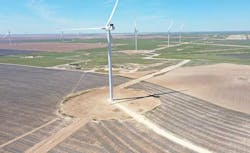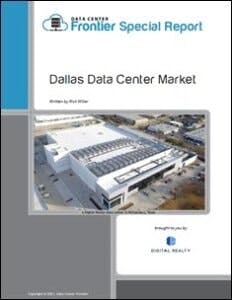Power Infrastructure and Tax Incentives Drive Dallas Data Center Market
Last week we continued a special report series on the Dallas data center market. This week, we’ll look at the Dallas/Ft. Worth business environment, including power and connectivity infrastructure, disaster risk, and tax incentives available in the region.
The discussion of power infrastructure and service in Dallas and other Texas markets is more relevant than ever in the wake of the February 2021 winter storm, in which frigid temperatures led to lengthy utility outages, coupled with price spikes when power was available. Some history and background on the grid in Dallas / Fort Worth are useful in discussing the storm, its impact and its legacy.
Texas is unique in that it is decoupled from the interconnected power grids serving the eastern and western United States. Among the contiguous 48 states, Texas is the only one that has a standalone electric grid entirely within the state. This means that with few exceptions, Texas produces the electricity consumed within its borders and is not subject to the Federal Power Act, a Depression-era law where the Federal Power Commission oversees all interstate electricity sales. The Electric Reliability Council of Texas (ERCOT), a nonprofit corporation governed by a board of directors and subject to oversight by the Public Utility Commission of Texas and the Texas Legislature, is responsible for managing 90% of the electricity in the state of Texas.
The State of Texas introduced competitive electric markets in 2002, creating a system where electric generation and supply is a retail business competing for customers while the transmission — often the incumbent owners of power lines — remains heavily regulated. The confluence of a competitive market, the abundance of in-state power sources (notably natural gas), and a standalone power grid have driven power costs in the Dallas/Fort Worth market down over the past few years. This low-cost power makes DFW more competitive, attracting both regional and national transactions.
For many years, Texas data center operators have argued that the independent ERCOT grid was an advantage, isolating Dallas and other large Texas markets from problems on other grids. The February winter storm put a dent in that argument, exposing the lack of winterization in many generation and transmission assets as a vulnerability.
In June, Texas Gov. Greg Abbott signed a package of reforms that will require ERCOT to weatherize energy facilities to handle extreme weather, creating substantial financial penalties for operators that fail to protect their equipment. The prompt action should prevent a repeat of some of the reliability and pricing issues seen in February. This may reassure companies weighing Dallas against non-Texas markets in data center site selection.
Texas has a growing supply of wind energy, which accounts for 20 percent of the electricity generated in Texas, up from 10 percent in 2015. During the early hours of the February winter event, some public officials and commentators pointed to the state’s reliance on wind energy as a culprit in the outages. Subsequent inquiries focused on the lack of weatherization as the core issue, exacerbated by the gas plants going offline and Texas grid’s isolation making it hard to source electricity beyond its borders.
Renewables are important, as the availability of green energy options is crucial to the DFW region’s aspirations to emerge as a player in deals with hyperscale providers, who require renewable energy to support their data centers and ESG commitments. Due to its intermittent nature, wind energy can be challenging to integrate into power grids. Texas has some advantages on this front, as it has an abundant supply of natural gas plants, which can adjust their power output more quickly than coal-fired plants.
The February storm may bring new business for the many commercial data centers who remained online throughout the event, as the lengthy utility outages knocked many on-premises data centers offline, reinforcing the value of using a third-party provider facility engineered for continuous operation through regional disasters.
Some Dallas providers cultivated good will with their customer support during the winter storm, most notably with Digital Realty, which provided diesel delivery to support a customer’s on-premises operations from running out of fuel.
Disaster Risk
Beyond the unusual winter storm, new entrants to the Dallas/Fort Worth market can sometimes worry about tornado risk. In addition, small earthquakes that have rattled the market recently have raised safety concerns. Data center providers in DFW know to address these concerns by designing facilities that meet building codes and withstand seasonal bouts of high-powered winds.
Tax Incentives Overview
Texas legislators passed a bill in 2013 to eliminate taxes paid on qualifying hardware and software purchases for data centers. While the exemption does not cover local sales taxes on purchases, data center owners/operators/occupants are 100% exempt from the 6.25% state sales and use taxes for up to fifteen years on electricity consumption and equipment purchases. This exemption includes purchases of servers, generators, storage devices, software, and other systems necessary for data center operations. To qualify, the data center must:
- Total 100,000 SF of gross building area
- Achieve a capital investment of $200+ million over a five-year period
- Create at least twenty permanent jobs for locals
- Pay wages equivalent to 120% of the national average
Connectivity Overview
Multiple carriers’ fiber networks blanket the DFW Metroplex connected to a robust last-mile infrastructure. Logix (a regional fiber provider based in Texas), CenturyLink, Cogent, EarthLink, FiberLight (another regional player based in Atlanta, GA), Level 3, Sprint, Verizon, Windstream, and XO all serve the Metroplex. Long-haul fiber from multiple carriers connects the urban centers of both Ft. Worth and Dallas. Telecom giant AT&T relocated their world headquarters to downtown Dallas in 2008 and the company’s long-haul fiber is prevalent in DFW. AT&T fiber runs through the Alliance Airport area (home to the new Facebook data center) south to downtown Ft. Worth, then west to downtown Dallas, and winds up into the northern suburbs of Carrollton and Lewisville — an area with several large colocation data centers. To the east in Dallas’ northern suburbs of Richardson and Plano, enterprise-grade fiber infrastructure attracted the majority of DFW’s new data center construction in the past five years.
Download the full report, Dallas Data Center Market, courtesy of Digital Realty to learn more about this competitive data center market. In our next article, we’ll explain Dallas’ “Big City Edge”. Catch up on previous articles here and here.
About the Author




